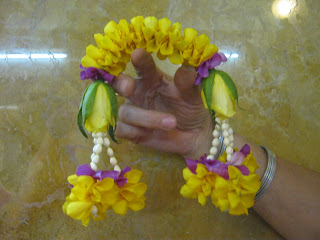Qualquer um que visite a ISKCON Chowpatty sente-se muito inspirado ao contemplar cada detalhe da suntuosa decoração das deidades de Sri Sri Radha Gopinatha, Sri Sri Gaura Nitai e Sri Nathaji e ver o capricho e dedicação com o qual os devotos executam serviço devocional. Muitas vezes o cuidado com as deidades se dá por trás das cortinas e a maioria das pessoas acaba tendo acesso apenas ao resultado ( e que resultado!) durante o darshan. No entanto, se você chegar no templo durante a aula do Srimad Bhagavatam, poderá testemunhar (e até mesmo participar) da elaboração de belos ornamentos florais usados para embelezar ainda mais as deidades. Trata-se do incrível seva das guirlandeiras de Chowpatty.
O que chama atenção é o refinado trabalho em espiral com pétalas de rosas e botões de jasmim que servem como base para guirlandas, cintos, brincos, coroas, etc. O amor com que elas executam esse serviço certamente é um ingrediente que faz com que as pessoas sintam a incrível atmosfera espiritual que emana daquele altar. E todo esse capricho não acontece somente para a decoração do festival de domingo. Mesmo durante a semana elas trabalham com o mesmo esmero e se há algum acontecimento elas não param a produção, como você pode ver na foto abaixo, durante o ratha Yatra da ISKCON Juhu.
Como há algum tempo várias devotas tem me pedindo pra criar um tutorial sobre esse trabalho, aí vai. Espero que tenha ficado fácil de entender:
O mesmo raciocínio se aplica para o espiral de botões de jasmim. Você regula a espessura que quer distanciando a agulha do botão. Depois é só cortar os cabinhos que sobraram.
Nada é desperdiçado. Aqui as folhas das rosas são utilizadas também. A técnica é a mesma das pétalas, mas nesse caso não é necessário cortar o excedente.
 |
Coloque um pedaço do talo de rosa na agulha para dar sustentação ao espiral
Destaque as pétalas do caule delicadamente
Dobre as pontas da pétala pra fora uniando-as no meio. A parte esbranquiçada que estava presa no caule é a que aparecerá na guirlanda dando o efeito degradé.
Caso a pétala esteja muito grande pro tamanho de guirlanda que você quer fazer remova a ponta em excesso
Acomode a pétala dobrada na agulha sobre a base.
Acomode a segunda pétala lateralmente à primeira e assim sucessivamente até...
Formar uma base com seis pétalas. A partir daí a sétima pétala será encaixada sobre a primeira, a oitava sobre a segunda, e assim sucessivamente...
... formando o espiral.
Para conseguir esse efeito, basta intercalar 3 pétalas vermelhas : 3 amarelas
Já esse espiral de 3 cores é feito com a sequência de 2 vermelhas : 2 amarelas : 2 rosas.
Esse outro é feito com a sequência de 1 vermelha : 2 rosas.
Esse tipo intercala 1 vermelha : 1 amarela
Espiral de pétalas ( 2 amarelas :2 vermelhas) na guirlanda que Radha oferece a Krishna e arranjo de cabeça de pétalas intercaladas com botões de jasmim.
Esse outro tipo é feito intercalando 2 botões de jasmim com o restante de pétalas.
Esse tipo é feito com 1 rosa : 2 amarelas : 1 vermelha : 2 amarelas
O mesmo raciocínio se aplica para o espiral de botões de jasmim. Você regula a espessura que quer distanciando a agulha do botão. Depois é só cortar os cabinhos que sobraram.
O mesmo raciocínio pode ser usado com essa pequena flor que se chama Aboli.
Apesar de delicada essa florzinha é bem resistente!
Tulasi mataji, uma devota senior muito querida, fazendo uma guirlanda com a flor Aboli
Depois é só montar as guirlandas, usando a sua imaginação. O interessante aqui é que cada devota contribui com um pedacinho da guirlanda de cada deidade e todas trabalham com um bonito espírito de cooperação.
Aqui temos uma mistura de botões de jasmim, pétalas de lótus e miolo de flor de lótus.
Nesse caso o jasmim é um pouco mais aberto dando esse visual mais solto, conforme close abaixo:
Botões de jasmim com pétalas de rosas e botões de rosas
Esse tipo mistura flores e frutas ( cerejas)
Arranjos de cabeça para Srimati Radharani
Preparando penduricalhos...
Ornamentos de cabeça de Srimati Radharani, com flores e frutas ( cerejas)
Turbante de Gopinatha com penduricalhos ( à direita)
Guirlanda em espiral ( 1 pétala rosa e 5 vermelhas) de Gopinatha com orquídeas. Detalhe para o cinto e para o belíssimo abdome protuberante de Krishna!
Sua serva
Vaisnava Krpa devi dasi
Clique no botão pra ver posts antigos logo acima


















































